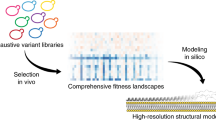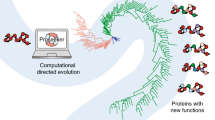Summary
The inherent infidelity of Taq DNA polymerase in the polymerase chain reaction was exploited to produce random mutations in thetrp A gene. Screening of the resulting clones allowed selection of non-interactive mutant α subunits retaining their intrinsic catalytic activity. Two single changes responsible for this phenotype were identified by DNA sequencing as: α126 valine (GTG)→glutamic acid (GAG) and α128 valine (GTT)→aspartic acid (GAT). Three single changes giving a non-interactive phenotype with an impaired intrinsic catalytic activity were identified by DNA sequencing as a66 asparagine (AAC)→aspartic acid (GAC); α109lysine (AAA) →arginine (AGA); α118 cysteine (TGC)→arginine (CGC). Where possible, we individually assessed the importance of these residues in αβ interaction in light of structural information from X-ray crystallography and by intergeneric protein sequence comparison.
Similar content being viewed by others
References
Ahmed SA, Kawasaki H, Bauerle R, Morita H, Miles EW (1988) Site-directed mutagenesis of the a subunit of tryptophan synthase ofEscherichia coli. Biochem Biophys Res Commun 151:672–678
Chen J, Viola MV (1991) A method to detectras point mutations in small subpopulations of cells. Anal Biochem 95:51–56
Crawford IP (1989) Evolution of a biosynthetic pathway: The tryptophan paradigm. Annu Rev Microbiol 43:567–600
Crawford IP, Johnson LM (1963) Mutants ofEscherichia coli defective in the B protein of tryptophan synthetase. I Selection and classification. Genetics 48:725–736
Crawford IP, Niermann T, Kirschner K (1987) Prediction of secondary structure by evolutionary comparison: Application to the α subunit of tryptophan synthase. Proteins: 2:118–129
Creighton TE (1970) A steady-state kinetic investigation of the reaction mechanism of the tryptophan synthetase ofEscherichia coli. Eur J Biochem 13:1–10
Creighton TE, Yanofsky C (1966) Association of the α and β2 subunits of the tryptophan synthase ofEscherichia coli. J Biol Chem 241:980–990
DiCamelli RF, Balbinder E (1976) The association of tryptophan synthetase subunits fromEscherichia coli andSalmonella typhimurium in homologous and heterologous combinations. Genet Res 27:323–333
DiCamelli RF, Balbinder E, Lebowitz J (1973) Pressure effects on the association of the α and β2 subunits of the tryptophan synthetase fromEscherichia coli andSalmonella typhimurium. Arch Biochem Biophys 155:315–324
Dunn MF, Aguilar V, Brzovic P, Drewe WF Jr, Houben KF, Leja CA, Roy M (1990) The tryptophan synthase bienzyme complex transfers indole between the α- and β-sites via a 25-30Å long tunnel. Biochemistry 29:8598–8607
Dunning AM, Talmund P, Humphries SE (1988) Errors in the polymerase chain reaction. Nucleic Acids Res 16:10393
Eckert KA, Kunkel TA (1990) High fidelity DNA synthesis by theThermus aquaticus DNA polymerase. Nucleic Acids Res 18:3739–3744
Foss K, McClain WH (1987) Rapid site-specific mutagenesis in plasmids. Gene 59:285–290
Freedberg WB, Hardman JK (1971) Structural and functional roles of the cysteine residues in the a subunit of theEscherichia coli tryptophan synthetase. III Studies with the bifunctional sulfhydryl reagent bismaleimidomethylether. J Biol Chem 246:1439–1448
Fuchareon S, Fuchareon G, Fuchareon P, Fukumaki Y (1989) A novel ochre mutation in the β-thassalemia gene of a Thai; Identification by direct cloning of the entire β-globin gene amplified using polymerase chain reaction. J Biol Chem 264:7780–7783
Gibson F, Gibson MI, Yanofsky C (1961) A mutational alteration of the tryptophan synthetase ofEscherichia coli. J Gen Microbiol 24:301–312
Goodenow M, Huet T, Saurin W, Kwok S, Sninsky J, WainHobson S (1989) HIV-1 isolates are rapidly evolving quasispecies: Evidence for viral mixtures and preferred nucleotide substitutions. J AIDS 2:344–352
Gschwind HP, Gschwind U, Paul CH, Kirschner K (1979) Affinity chromatography of tryptophan synthase fromEscherichia coli. Eur J Biochem 96:403–416
Hardman JK, Hardman DF (1971) Reaction of the a subunit of theEscherichia coli trptophan synthase with 1,5-difluoro-2,4-dinitrobenzene. J Biol Chem 246:6489–6496
Hardman JK, Yanofsky C (1965) Studies on the active site of the A protein subunit of theEscherichia coli tryptophan synthetase. J Biol Chem 240:725–732
Hill PJ, Swift S, Stewart GSAB (1991) PCR-based gene engineering of theVibrio harveyi lux operon and theEscherichia coli trp operon provides for biochemically functional native and fused gene products. Mot Gen Genet 226:41–48
Ho SN, Hunt HD, Horton RM, Pullen JK, Pease LR (1989) Site directed mutagenesis by overlap extension using the polymerase chain reaction. Gene 77:51–59
Horton RM, Hunt HD, Ho SN, Pullen JK, Pease LR (1989) Engineering hybrid genes without the use of restriction enzymes: Gene splicing by overlap extension. Gene 77:61–68
Hyde CC, Ahmed SA, Padlan EA, Miles EW, Davies DR (1988) Three dimensional structure of the tryptophan synthase α2β2 multienzyme complex fromSalmonella typhimurium. J Biol Chem 263:17857–17871
Innis MA, Myambo KB, Gelfland DH, Brow MAD (1988) DNA sequencing withThermus aquaticus DNA polymerase and direct sequencing of polymerase chain reaction amplified DNA. Proc Natl Acad Sci USA 85:9436–9440
Iwanejko LA, Routledge MN, Stewart GSAB (1989) Cloning inEscherichia coli of the enterotoxin gene fromClostridium perfringens Type A. J Gen Microbiol 135:903–909
Jones DH, Howard BH (1990) A rapid method for site specific mutagenesis and directional subcloning by using the polymerase chain reaction to generate recombinant circles. Biotechniques 8:178–183
Kawasaki H, Bauerle R, Zon G, Ahmed SA, Miles EW (1987) Site specific mutagenesis of the a subunit of tryptophan synthase fromSalmonella typhimurium. J Biol Chem 262:10678–10683
Kirschner K, Wiskocil RL, Faehn M, Rezeau L (1975) The tryptophan synthase ofEscherichia coli. An improved purification procedure for the a subunit and binding studies with substrate analogues. Eur J Biochem 60:512–523
Lane AN, Kirschner K (1983a) The mechanism of binding ofL-serine to tryptophan synthase fromEscherichia coli. Eur J Biochem 129:675–684
Lane AN, Kirschner K (1983b) The catalytic mechanism of tryptophan synthase fromEscherichia coli. Kinetics of the reaction of indole with the enzyme-L-serine complexes. Eur J Biochem 129:675–684
Malkinson AM, Hardman JK (1969) Structural and functional roles of the cysteine residues in the a subunit of theEscherichia coli tryptophan synthetase. 1. Structural roles and reactivity of the cysteine residues. Biochemistry 8:2769–2776
Manney TR (1970) Physiological advantage of the mechanism of the tryptophan synthase reaction. J Bacteriol 102:483–488
Miles WE (1979) Tryptophan synthetase. Adv Enzymol 49:127–186
Miles EW, Bauerle R, Ahmed SA (1987) Tryptophan synthase fromEscherichia coli andSalmonella typhimurium. Methods Enzymol 142:398–414
Miller JH (1972) Experiments in molecular genetics. Cold Spring Harbor Laboratory Press, Cold Spring Harbor, New York
Murgola EJ, Adelberg EA (1970) Streptomycin-suppressible lethal mutations inEscherichia coli. J Bacteriol 103:20–26
Murgola EJ, Hijazi KA (1983) Selection for new codons corresponding to position 234 of the tryptophan synthetase alpha chain ofEscherichia coli. Mot Gen Genet 191:132–137
Murgola EJ, Yanofsky C (1974) Selection for new amino acids at position 211 of the tryptophan synthetase a chain ofEscherichia coli. J Mot Biol 86:775–784
Myers RM, Sheffield VC, Cox DR (1989) Mutation detection by PCR, GC-clamps and denaturing gradient gel electrophoresis. In: Erlich EA (ed) PCR technology: Principles and applications for DNA amplification. MacMillan UK, pp 71–97
Saiki RK, Gelfand DH, Stoffel S, Scharf SJ, Higuchi R, Horn GT, Mullis KB, Erlich HA (1988) Primer-directed enzymatic amplification of DNA with a thermostable DNA polymerase. Science 239:487–491
Sambrook J, Fritsch EF, Maniatis T (1989) Molecular cloning. A laboratory manual. Second edition. Cold Spring Harbor Laboratory Press, Cold Spring Harbor, New York
Stewart GSAB, Lubinsky-Mink S, Kuhn J (1986) pHG276: A multiple cloning site pBR322 copy number vector expressing a functionallac⇓ peptide from the bacteriophageLambda P R promoter. Plasmid 15:182–190
Swift S, Stewart GSAB (1991) The molecular biology of tryptophan synthase: A model for protein-protein interaction. In: Tombs MP (ed) Biotechnol Genet Eng Rev 9: Intercept UK, pp 229–294
Tindall KR, Kunkel TA (1988) Fidelity of DNA synthesis by theThermus aquaticus DNA polymerase. Biochemistry 27:6008–6013
Tucker SD, Murgola EJ, Hijazi KA (1989) Reversion oftrpA nonsense mutations by deletion of the chain termination codons. Biochimie 71:721–728
Williams JF (1989) Optimization strategies for the polymerase chain reaction. Biotechniques 7:762–769
Yanofsky C (1956) The enzymatic conversion of anthranilic acid to indole. J Biol Chem 273:171–184
Yanofsky C (1987) Tryptophan synthetase: Its charmed history. Bioessays 6:133–137
Author information
Authors and Affiliations
Rights and permissions
About this article
Cite this article
Swift, S., Kuhn, J. & Steward, G.S.A.B. Selection and analysis of non-interactive mutants in theEscherichia coli tryptophan synthase a subunit. Molec. Gen. Genet. 233, 129–135 (1992). https://doi.org/10.1007/BF00587570
Received:
Issue Date:
DOI: https://doi.org/10.1007/BF00587570




